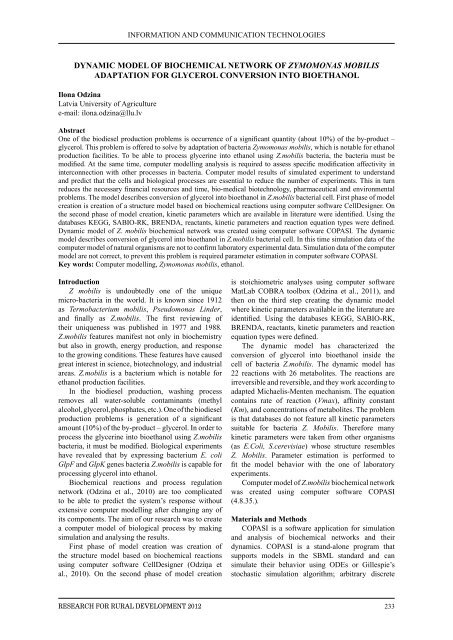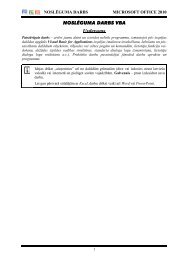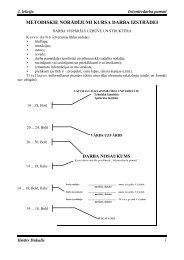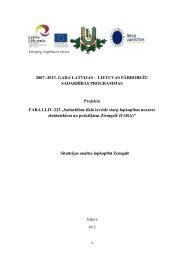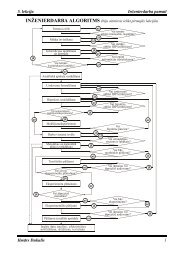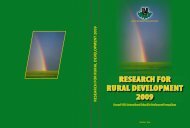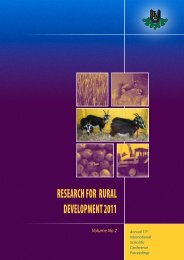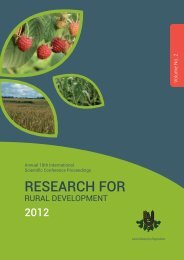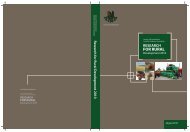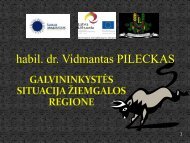LATVIA UNIVERSITY OF AGRICULTURE - Latvijas ...
LATVIA UNIVERSITY OF AGRICULTURE - Latvijas ...
LATVIA UNIVERSITY OF AGRICULTURE - Latvijas ...
- No tags were found...
You also want an ePaper? Increase the reach of your titles
YUMPU automatically turns print PDFs into web optimized ePapers that Google loves.
INFORMATION AND COMMUNICATION TECHNOLOGIESDynamic Model of biochemical network of Zymomonas mobilisADAPTATION for GLYCEROL conversion INTO bioethanolIlona OdzinaLatvia University of Agriculturee-mail: ilona.odzina@llu.lvAbstractOne of the biodiesel production problems is occurrence of a significant quantity (about 10%) of the by-product –glycerol. This problem is offered to solve by adaptation of bacteria Zymomonas mobilis, which is notable for ethanolproduction facilities. To be able to process glycerine into ethanol using Z.mobilis bacteria, the bacteria must bemodified. At the same time, computer modelling analysis is required to assess specific modification affectivity ininterconnection with other processes in bacteria. Computer model results of simulated experiment to understandand predict that the cells and biological processes are essential to reduce the number of experiments. This in turnreduces the necessary financial resources and time, bio-medical biotechnology, pharmaceutical and environmentalproblems. The model describes conversion of glycerol into bioethanol in Z.mobilis bacterial cell. First phase of modelcreation is creation of a structure model based on biochemical reactions using computer software CellDesigner. Onthe second phase of model creation, kinetic parameters which are available in literature were identified. Using thedatabases KEGG, SABIO-RK, BRENDA, reactants, kinetic parameters and reaction equation types were defined.Dynamic model of Z. mobilis biochemical network was created using computer software COPASI. The dynamicmodel describes conversion of glycerol into bioethanol in Z.mobilis bacterial cell. In this time simulation data of thecomputer model of natural organisms are not to confirm laboratory experimental data. Simulation data of the computermodel are not correct, to prevent this problem is required parameter estimation in computer software COPASI.Key words: Computer modelling, Zymomonas mobilis, ethanol.IntroductionZ mobilis is undoubtedly one of the uniquemicro-bacteria in the world. It is known since 1912as Termobacterium mobilis, Pseudomonas Linder,and finally as Z.mobilis. The first reviewing oftheir uniqueness was published in 1977 and 1988.Z.mobilis features manifest not only in biochemistrybut also in growth, energy production, and responseto the growing conditions. These features have causedgreat interest in science, biotechnology, and industrialareas. Z.mobilis is a bacterium which is notable forethanol production facilities.In the biodiesel production, washing processremoves all water-soluble contaminants (methylalcohol, glycerol, phosphates, etc.). One of the biodieselproduction problems is generation of a significantamount (10%) of the by-product – glycerol. In order toprocess the glycerine into bioethanol using Z.mobilisbacteria, it must be modified. Biological experimentshave revealed that by expressing bacterium E. coliGlpF and GlpK genes bacteria Z.mobilis is capable forprocessing glycerol into ethanol.Biochemical reactions and process regulationnetwork (Odzina et al., 2010) are too complicatedto be able to predict the system’s response withoutextensive computer modelling after changing any ofits components. The aim of our research was to createa computer model of biological process by makingsimulation and analysing the results.First phase of model creation was creation ofthe structure model based on biochemical reactionsusing computer software CellDesigner (Odziņa etal., 2010). On the second phase of model creationis stoichiometric analyses using computer softwareMatLab COBRA toolbox (Odzina et al., 2011), andthen on the third step creating the dynamic modelwhere kinetic parameters available in the literature areidentified. Using the databases KEGG, SABIO-RK,BRENDA, reactants, kinetic parameters and reactionequation types were defined.The dynamic model has characterized theconversion of glycerol into bioethanol inside thecell of bacteria Z.mobilis. The dynamic model has22 reactions with 26 metabolites. The reactions areirreversible and reversible, and they work according toadapted Michaelis-Menten mechanism. The equationcontains rate of reaction (Vmax), affinity constant(Km), and concentrations of metabolites. The problemis that databases do not feature all kinetic parameterssuitable for bacteria Z. Mobilis. Therefore manykinetic parameters were taken from other organisms(as E.Coli, S.cerevisiae) whose structure resemblesZ. Mobilis. Parameter estimation is performed tofit the model behavior with the one of laboratoryexperiments.Computer model of Z.mobilis biochemical networkwas created using computer software COPASI(4.8.35.).Materials and MethodsCOPASI is a software application for simulationand analysis of biochemical networks and theirdynamics. COPASI is a stand-alone program thatsupports models in the SBML standard and cansimulate their behavior using ODEs or Gillespie’sstochastic simulation algorithm; arbitrary discreteResearch for Rural Development 2012233


